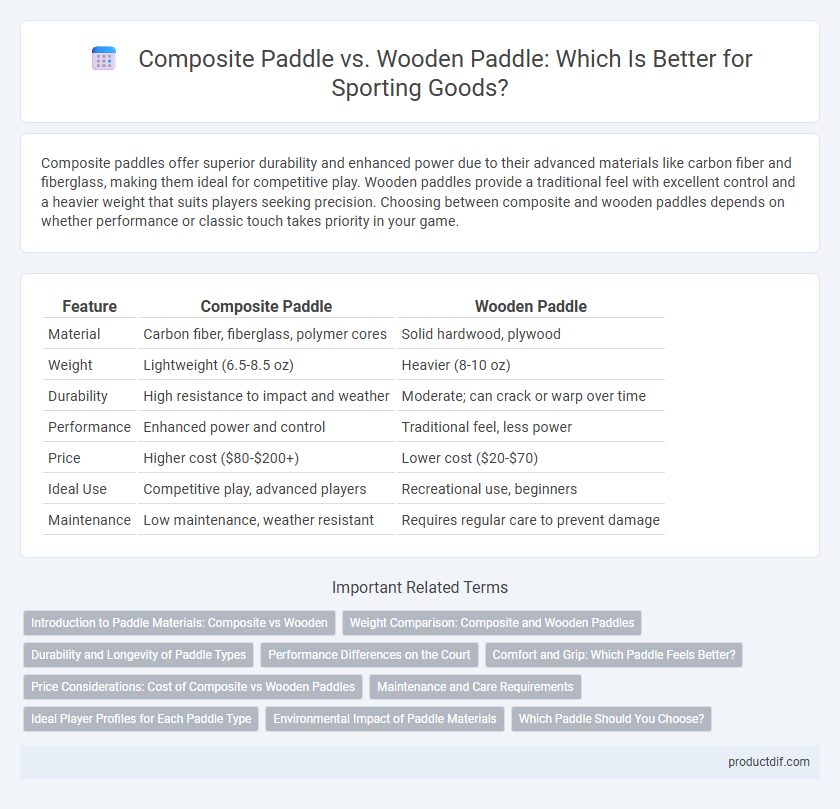Composite paddles offer superior durability and enhanced power due to their advanced materials like carbon fiber and fiberglass, making them ideal for competitive play. Wooden paddles provide a traditional feel with excellent control and a heavier weight that suits players seeking precision. Choosing between composite and wooden paddles depends on whether performance or classic touch takes priority in your game.
Table of Comparison
| Feature | Composite Paddle | Wooden Paddle |
|---|---|---|
| Material | Carbon fiber, fiberglass, polymer cores | Solid hardwood, plywood |
| Weight | Lightweight (6.5-8.5 oz) | Heavier (8-10 oz) |
| Durability | High resistance to impact and weather | Moderate; can crack or warp over time |
| Performance | Enhanced power and control | Traditional feel, less power |
| Price | Higher cost ($80-$200+) | Lower cost ($20-$70) |
| Ideal Use | Competitive play, advanced players | Recreational use, beginners |
| Maintenance | Low maintenance, weather resistant | Requires regular care to prevent damage |
Introduction to Paddle Materials: Composite vs Wooden
Composite paddles, crafted from carbon fiber and fiberglass, offer superior durability, lightweight performance, and enhanced power compared to traditional wooden paddles used in sports like pickleball and table tennis. Wooden paddles provide a classic feel with natural shock absorption but tend to be heavier and less resilient to moisture and wear over time. The choice between composite and wooden paddles significantly impacts gameplay, with composites favored for speed and control while wooden paddles appeal to players seeking a traditional touch and affordability.
Weight Comparison: Composite and Wooden Paddles
Composite paddles typically weigh between 7.5 to 8.5 ounces, offering a lighter option compared to wooden paddles, which usually range from 8.5 to 10 ounces. The reduced weight of composite paddles enhances maneuverability and reduces player fatigue during extended play. In contrast, the heavier wooden paddles provide more power but may compromise speed and agility on the court.
Durability and Longevity of Paddle Types
Composite paddles offer superior durability compared to wooden paddles due to their resistance to moisture, warping, and impact damage, making them ideal for long-term use. Wooden paddles, while traditional and aesthetically pleasing, tend to absorb water and are more susceptible to cracking, reducing their longevity. Investing in composite materials ensures a paddle maintains structural integrity and performance over extended periods, especially in diverse playing conditions.
Performance Differences on the Court
Composite paddles offer superior power and control due to their lightweight materials and advanced construction, enabling quicker swings and more precise ball placement on the court. Wooden paddles, while heavier and less responsive, provide enhanced durability and a traditional feel preferred by some players for touch shots. The performance differences significantly impact gameplay, with composite paddles favoring aggressive, fast-paced styles and wooden paddles supporting controlled, strategic play.
Comfort and Grip: Which Paddle Feels Better?
Composite paddles offer superior comfort with ergonomic designs and shock-absorbing materials that reduce hand fatigue during extended play. Wooden paddles provide a natural grip feel but often lack the enhanced cushioning found in composites, which can impact long-term comfort. The textured surface of composite paddles delivers better grip security, making them favorable for players prioritizing control and comfort.
Price Considerations: Cost of Composite vs Wooden Paddles
Composite paddles typically cost between $70 and $150, offering advanced materials like carbon fiber that enhance durability and performance. Wooden paddles, generally priced from $20 to $60, provide a budget-friendly option but lack the lightweight and strength benefits of composite designs. Investing in a composite paddle often results in longer lifespan and improved play quality despite the higher initial expenditure.
Maintenance and Care Requirements
Composite paddles require less maintenance and are more resistant to moisture, warping, and cracking compared to wooden paddles. Wooden paddles need regular sealing and careful drying to prevent damage from water exposure and temperature fluctuations. Proper care for composite paddles mainly involves cleaning with mild soap and avoiding prolonged sun exposure to maintain performance and longevity.
Ideal Player Profiles for Each Paddle Type
Composite paddles suit advanced and competitive players seeking lightweight equipment with enhanced control and power for fast-paced gameplay. Wooden paddles are ideal for beginners and recreational players who prefer durability, affordability, and a solid feel for slower, more controlled shots. Players focused on finesse and spin benefit from composite paddles, while those valuing stability and impact feedback often choose wooden paddles.
Environmental Impact of Paddle Materials
Composite paddles outperform wooden paddles in environmental sustainability due to their longer lifespan and recyclability, reducing waste over time. Wooden paddles, sourced from hardwood trees, contribute to deforestation and require more intensive natural resource consumption during production. The use of eco-friendly resins and recycled fibers in composite paddles further minimizes carbon emissions and environmental degradation compared to traditional wooden counterparts.
Which Paddle Should You Choose?
Composite paddles offer superior durability, lightweight performance, and better control, making them ideal for serious players seeking enhanced power and precision. Wooden paddles provide a traditional feel and solid feedback but tend to be heavier and less forgiving, suitable for beginners or casual players. Your choice depends on your skill level, playing style, and preference for paddle weight and responsiveness.
Composite paddle vs Wooden paddle Infographic

 productdif.com
productdif.com